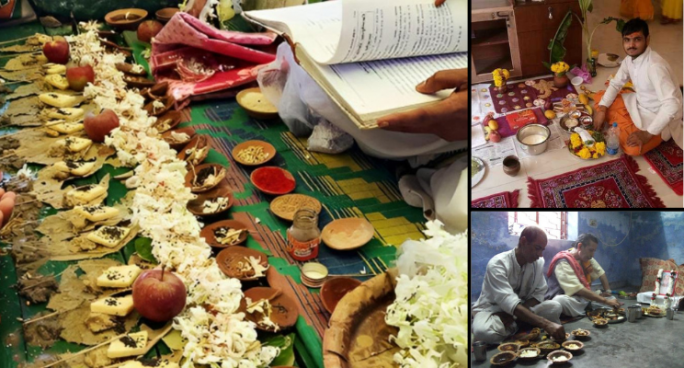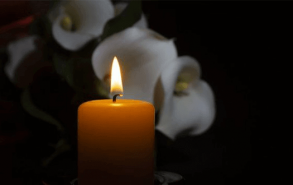Lastjourney Blog
After Death Rituals in Hinduism, Customs, Final Rites

 Table of Contents
Table of Contents- The Journey Beyond After-Death Rituals in Hinduism
- How You Can Prepare for the Final Journey in Hinduism
- After Cremation Rituals in Hinduism
- Importance of Sharadh Rituals in Hinduism after Death
- Why Rituals are Important in Hinduism:
- How Rituals have changed from the past to the present time in Hinduism?
The Journey Beyond After-Death Rituals in Hinduism
Demise, in Hinduism, is viewed as a change, where the soul transforms from one world to another. The intricate after-death rituals in the Hindu religion are aimed toward guaranteeing a smooth transition for the left soul and their possible freedom.
These ceremonies, known as Antyesti (last penance) or Antim Sanskar (last ceremony), are a series of customs that guide the spirit on its forward venture smoothly. Rituals in Hindu after death encompass a series of ceremonies performed after the passing of a person.
These ceremonies are directed by old texts and customs that differ across districts and communities however share normal standards established in the rituals in Hindu after death.
How You Can Prepare for the Final Journey in Hinduism
The immediate aftermath according to customs and traditions of Hinduism after death in a Hindu family is set apart by grieving and the beginning of arrangements for the Antyesti. The body is viewed as holy, and approaching it with deference is basic.
Commonly, the oldest child or a male relative washes the body with cleaning substances like ghee (explained spread), milk, and yoghurt. The body is embellished with sandalwood glue (for guys) or turmeric (for females), and wearing new garments.
How does the family get ready for the Antyesti?
1. Body Preparation: The body is washed and wearing clean attire, frequently white or another straightforward variety representing virtue. In certain customs, the top of the departed is shaved, representing separation from common connections.
2. Placement and Preparation: The body is commonly put on a coffin or cot and enhanced with blossoms and hallowed things. A light (Diya) might be lit close to the top of the departed to represent the presence of light and disperse dimness.
3. Prayers and Mantras: Vedic serenades and petitions to God are presented by relatives or ministers to conjure divine endowments and work with the spirit's excursion to life following death.
4. Funeral Procession: The body is then taken to the incineration ground (Shmashana) or entombment site (contingent upon local traditions) in a memorial service parade. Relatives and grievers go with the parade, extending appreciation and backing for the left soul and their friends and family.
The Antyesti Ceremony After Death
The Antyesti, generally held in no less than 24 hours of death, is an incineration function performed on a fire developed from consecrated woods like sandalwood. A Hindu minister directs the service, driving loved ones in supplications and serenades.
Contributions of food and sesame seeds are set close to the body, representing food for the left on their excursion. The oldest child, or assigned male griever, assumes an urgent part. Circumambulating the fire with the body, they offer a tribute and get the fire going. The demonstration of incineration connotes the arrival of the spirit from its natural vessel.
The steps involved in the Antyesti which is one of the most significant rituals in Hindu after-death ceremonies include but are not limited to the following steps; -
1. Ritual Preparation: Before lighting the burial service fire, explicit ceremonies and petitions to God are directed to cleanse the body and purify the incineration ground. Contributions, for example, rice grains and sesame seeds might be put in the mouth of the departed to represent sustenance for the spirit on its excursion.
2. Lighting the Pyre: The oldest child or another male relative customarily lights the memorial service fire utilizing fire from a holy source, for example, a light that has been consumed ceaselessly in a sanctuary. This act represents the arrival of the spirit from its actual body and its change to the otherworldly domain.
3. Prayers and Offerings: All through the incineration cycle, petitions (Mantras) from holy texts, for example, the Vedas are recounted to conjure divine gifts and guarantee the harmony and prosperity of the withdrawn soul. Contributions of explained spread (ghee), grains, and holy spices may likewise be made to conciliate gods and progenitors.
4. Ashes (Asthi) Visarjan: After the incineration is finished, the excess cinders (Asthi) are gathered and normally drenched in a consecrated stream, like the Ganges, or one more waterway. This demonstration, known as Asthi Visarjan, represents the last detachment of the spirit from its human remaining parts and its re-visitation of the components of nature.
Variations and Regional Customs
While cremation is the most widely recognized practice, provincial varieties exist as Hinduism is divided into different castes, and each one of them has some differences in rituals in Hinduism after death. Sometimes, depending upon age, conjugal status, or social standing, “peeths” known as udgam sthal (place of incarnation) are created for people who are deeply devoted or are saints.
According to rituals in Hindu after death, Youngsters up to 10 years of age or pregnant ladies might be buried rather than burnt. Explicit ceremonies and rituals in Hindus after death additionally change across various areas of India.
Scattering the Ashes - Niravapanjali
After the cremation, the leftovers of the fire are gathered. A function called Niravapanjali follows, where the nearest family members, normally children, submerge the leftovers in a holy river, preferably the Ganges. This drenching implies the last partition of the spirit from the actual body and its excursion towards eternity.
People also visit “bheve” a place in Haryana for the religious rituals of Hindus after death to attain peace for the soul, you must know what are the dos and don'ts after death in Hinduism.
After Cremation Rituals in Hinduism
Antyesti is marked as the final rite in Hindus amongst the after-death rituals in the Hindu religion. Several rituals continue to take place in the subsequent week. This includes Tarpana, and Pind Daan (supervised by the pandits) to offer solemnity to the deceased.
Once these after-death rituals in Hinduism are performed, only shradh which is an annual ritual post-death in Hinduism is conducted to ensure the peace and well-being of the departed in the afterlife.
Must Read- Rituals to be Performed after Death in Hinduism
Importance of Sharadh Rituals in Hinduism after Death
Mourning and Observances
The period after death is a period of grieving for the family. Direct relations might notice explicit dietary limitations and keep away from get-togethers. Nonetheless, the general opinion is one of working with the departed's afterlife journey and guaranteeing their tranquillity in the hereafter.
Each year, post dev shayan Ekadashi, 16 days is observed in the name of all ancestors. As Shradh rituals after death in Hinduism, or Pitru Paksha, is a yearly recognition committed to regarding predecessors and left relatives. This period ordinarily happens in the lunar month of Bhadrapada (September-October) and includes performing explicit ceremonies and contributions to guarantee the prosperity of the left spirits in the great beyond.
After-death rituals in Hindus such as shradh hold deep significance for different reasons:
- The rituals are believed to help the departed soul navigate the transition smoothly.
- In case some rituals are missed or underperformed amidst death time, these shradhs help in fulfilling the formalities missed.
- By performing after-death Hindu rituals like Shraadh, Hindus maintain a connection with their ancestors and pray for a hassle-free afterlife.
After-death rituals in Hindus offer a way to navigate loss and guide the soul toward its next journey. These traditions, are considered as elongated and elaborated but as per the customs and traditions after death in Hindus, provide comfort and solace to the bereaved family and ensure the well-being of the departed in the afterlife.
Why Rituals are Important in Hinduism:
The customs and rituals after death in Hinduism fill numerous needs past their strict and profound importance. They give an organized system for exploring the close-to-home and mental parts of despondency, offering solace and comfort to the dispossessed family. These customs likewise support social qualities and customs that went down through the ages, saving a feeling of congruity and character inside the local area.
Also, the Hindu last rituals highlight essential standards of the Hindu way of thinking, including the ideas of karma (law of circumstances and logical results), dharma (obligation and uprightness), and moksha (freedom from the pattern of resurrection).
By playing out these customs with genuineness and commitment, Hindus accept they can work with the spirit's excursion to higher profound domains and guarantee its definitive freedom from natural connections. In simple words, the older son must ensure that his deceased parent gets a respected funeral and also follows Sanatan dharma, as this one religion talks about humanity as the premium religion even over their respected religions so that their loved one attains eternity.
How Rituals have changed from the past to the present time in Hinduism?
In contemporary times, while numerous Hindu families stick near customary ceremonies and customs, there is likewise a developing pattern towards adjusting these practices to present-day settings. Factors like urbanization, globalization, and changing relational intricacies have affected how last customs are performed and experienced. A few striking contemporary practices and transformations include:
1. Crematorium Facilities: Present-day crematoriums outfitted with cutting-edge offices oblige the customs of incineration and Asthi Visarjan. These offices comply with ecological guidelines and furnish families with more prominent adaptability in leading last customs.
2. Alternative Memorialization: notwithstanding customary incineration and entombment rehearses, Hindu families might investigate elective types of memorialization, for example, making remembrance gardens, establishing trees, or laying out magnanimous establishments in memory of the departed.
3. Community and Sanctuary Services: Public venues, sanctuaries, and strict associations offer administration and backing to families during the grieving time frame and Shraadh functions. These organizations give otherworldly direction, guidance, and assets to assist families with exploring the intricacies of sadness and misfortune.
4. Globalization and Diaspora Communities: Hindu people groups living external India and in different social settings frequently adjust customary ceremonies to reflect nearby traditions and guidelines while saving centre strict standards. This social variation guarantees that Hindu last rituals stay significant and applicable across geological limits.
Final Words;
In simple words, Hindu Last rights envelop a rich embroidery of customs, customs, and customs that mirror the profound otherworldly, social, and philosophical underlying foundations of Hinduism. These ceremonies serve not exclusively to respect the memory of the withdrawn yet in addition to direct the spirit through its excursion to existence in the wake of death and then some.
It becomes significant to understand and respect the rituals of Hindus after death as different sentiments (emotional and religious) are connected. Hinduism is all about ensuring the health of their loved ones, and this time it is about those who left for the heavenly abode, and the remaining duties are fulfilled by their loved ones.
After-death rituals in Hinduism give a chance to thank the deceased for what they have done and given others so that they can feel overwhelmed as they transit from one life to another at peace.
FAQs
Q1. What are the Hindu's last customs?
Ans- The last ritual after death is called antyesthi. It is often done in 24 hours post-death, to get peace for the deceased and make the transition between two different worlds easy.
Q2. What is the meaning of Hindu last customs?
Ans- The meaning of Hindu last customs lies in their capacity to give conclusion and otherworldly help to both the withdrawn soul and the deprived family. These customs include antyesthi, tarpan and shradh.
Q3. What are a few normal ceremonies in Hindu last rituals?
Ans- A few examples of ceremonies as rituals for Hindus will be conducting antyesthi, Getting pind daan, done, and conducting shradh in the name of the deceased so that the soul can rest at peace comfortably.
Q4. Is there a ritual not directly related to the deceased person?
Ans- No, each ritual after death in Hinduism is directly related to the deceased person.
Q5. List the 5 rituals which Hindus perform as rituals in Hindus after death.
Ans- However, there are different rituals in Hindus after death, to name a few including getting antyesthi done, as it gets time to heal for even those people who were closely associated with the deceased.
Your email address will not be published. Required fields are marked *













